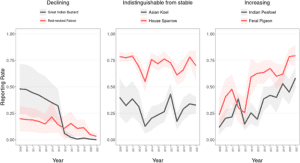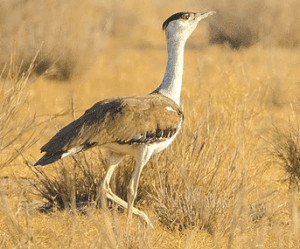TAG: GS 3: ECOLOGY AND ENVIRONMENT
THE CONTEXT: The grasslands of Nannaj, Maharashtra, are part of a diverse landscape that supports a wide array of fauna, including the critically endangered great Indian bustard. Despite their ecological significance, these grasslands are shrinking, leading to alarming declines in bird species.
EXPLANATION:
- Nannaj’s grasslands are situated within a complex mosaic of afforested woodlands, human settlements, grazing lands, and agricultural fields.
- The Great Indian Bustard Sanctuary is located here, adding to the area’s ecological importance.
- These grasslands are experiencing significant changes, affecting both the landscape and the avian community.
Study Observations in Five Villages
- A study conducted over 13 years (2009-2021) in five villages—Vadala, Akolekati, Karamba, Mardi, and Narotewadi—within the Nannaj region recorded trends in bird species.
- Using the citizen science app, eBird, researchers identified 199 species in Nannaj, but the study focused on 45 species, including seven migratory ones.
- Smaller-bodied, diet-generalist species showed stability or increased in population, while large-bodied, specialist birds like the great Indian bustard experienced severe declines.
- Additionally, some smaller-bodied specialist birds, such as the great grey shrike and red-necked falcon, also declined significantly.
- Two species, the great Indian bustard and the western marsh harrier, were examined closely.
- The latter, a top predator and ground-nester migrating from central Asia, showed steady declines in Nannaj, reflecting trends from other long-term studies.
- The great Indian bustard, initially showing seasonal patterns, has seen such a sharp decline that no seasonality is now apparent, aligning with national trends.

Importance of Open Natural Ecosystems
- Open Natural Ecosystems, including deserts, grasslands, and shrublands, cover at least 10% of India’s landmass.
- These ecosystems support diverse fauna such as the Indian wolf, blackbuck, and the great Indian bustard.
- Despite their ecological importance, 68% of these ecosystems are classified as wastelands, with less than 5% legally protected.
- These habitats, offering fertile soils, are among the most extensively modified.
Impact of Habitat Changes
- Farmers in the region recall frequent sightings of great Indian bustards in their fields, a memory not reflected in recent years.
- Agricultural activities, including the cultivation of crops like jowar, bajra, soybean, sunflower, urad dal, and groundnut, contribute to habitat changes impacting bird populations.
- Birds preferring woodland or scrublands, such as the small minivet, showed increasing reporting rates, while species like the painted sandgrouse experienced declines.
- Afforestation efforts in the 1980s, planting neem and anjan trees over native grasslands, have been partially reversed to restore grasslands for the declining great Indian bustard population.
Conservation Challenges and Initiatives
- Grassland birds, being ground-nesters highly sensitive to habitat changes, serve as indicators of ecosystem health.
- Studies suggest that low-intensity agro-pastoral lands can supplement protected areas in conserving grassland species.
- However, increased agricultural activity leads to declines in sensitive bird populations.
- Excessive grazing and frequent fires pose significant threats.
- Fires, though essential for regeneration, are set so frequently that the flora cannot complete its life cycles.
- Grass species resistant to fire, such as Heteropogon contortus and another known locally as pandhri kusal, dominate, reducing the original diversity of over 40 grass species.
- Awareness campaigns and fireline establishment are efforts to protect grassland patches.
Future Prospects and Renewable Energy Projects
- In November 2022, Tata Power Renewable Energy received approval to set up a 150 MW solar energy farm in Solapur, with work expected to commence in 2025.
- Policies for renewable energy projects often target “wastelands,” making grasslands vulnerable to land use changes.
- Renewable energy projects in India are currently exempt from environmental impact assessments (EIAs), a gap that could overlook potential ecological impacts.
Role of Pastoralism
- Pastoralism, historically sustainable within grasslands, faces challenges due to socio-economic pressures and policy misclassifications.
- Pastoralists are often categorized as farmers, hindering policy frameworks that could align pastoralist needs with conservation goals.
- Community-led management of savannah grasslands offers potential for integrating pastoralism and conservation efforts.
Restoration Efforts and Future Directions
- Targeted restoration efforts for native grasslands and Open Natural Ecosystems are essential.
- Grassland restoration projects in Rajasthan and Maharashtra aim to integrate these habitats into conservation frameworks.
- Consistent observations by local birdwatchers, even from home gardens, can yield valuable data on local bird community trends.
Great Indian bustard:
- It is known as the Indian Bustard, is a majestically large bird found on the Indian subcontinent.
- It is one of the heaviest flying birds in the world, with males reaching up to 1.2 meters (4 feet) tall and weighing in at 15 kg (33 pounds).
- These birds are easily distinguished by their black crown contrasting with their pale neck and head, and their brownish body with black, brown, and grey markings on their wings.
- The Great Indian Bustard is classified as critically endangered. Once common on the dry plains of India, there are only an estimated 150 individuals left in the wild.
- There are two main threats to their existence: habitat loss and hunting.
- Their natural habitat consists of large expanses of dry grasslands and scrub. However, this habitat is being lost due to agricultural development, overgrazing, and the planting of trees. Great Indian Bustards are hunted for their meat and feathers.
- The great Indian bustard was distributed throughout Western India, spanning 11 states, as well as parts of Pakistan. Its stronghold was once the Thar desert in the north-west and the Deccan plateau of the peninsula. Today, its population is confined mostly to Rajasthan and Gujarat.

SOURCE: https://scroll.in/article/1068430/bird-species-on-the-decline-as-maharashtra-grasslands-shrink
Spread the Word



